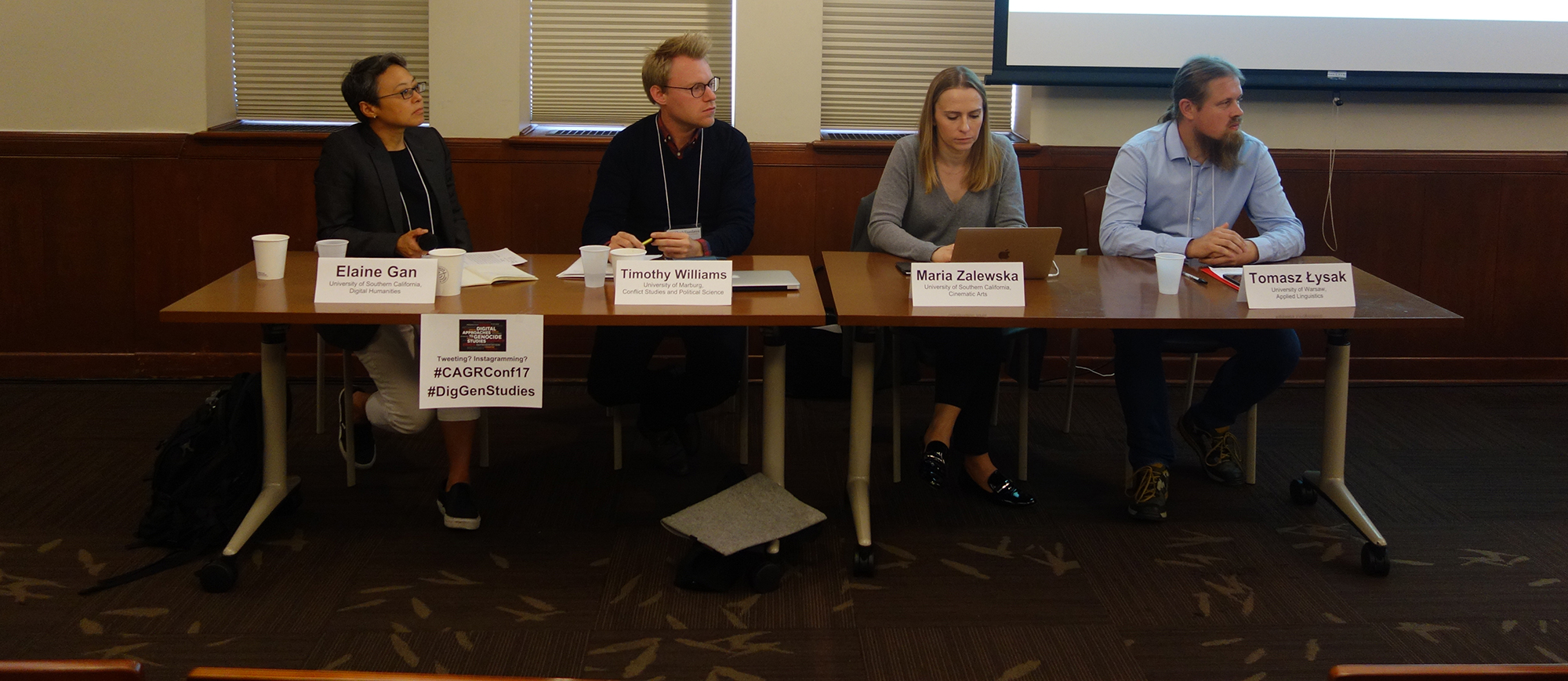Pokemon Go, YouTube and Trip Advisor at Digital Approaches to Genocide Studies Conference

Scholars Maria Zalewska, Timothy Williams and Tomasz Łysak delved into some of the newest ways genocide museum visitors are sharing their experiences on social media in the panel discussion “Social Media, Genocide Commemoration and Augmented Reality” on the first day of the “Digital Approaches to Genocide Studies” conference at USC Shoah Foundation Center for Advanced Genocide Research.
Łysak, from the University of Warsaw, began with a presentation about the fitness model/social media personality Heidi Somers, who posted a vlog last year about her experience visiting the Auschwitz-Birkenau State Museum - a stark departure from her usual posts about workout tips and diet advice. The vlog was posted on Somers’ YouTube channel and shared on her Facebook, Twitter and Instagram accounts, racking up over four million views over the past year.
Łysak pointed out that Somers functions as both a filmmaker and popular historian, since she made editorial choices about what to show in her video about her trip and what to leave out. She also shares some of the facts she learned during her visit, although she gets a few details wrong.
But her larger message, Łysak believes, is one of self-improvement and personal growth.
“She went to Auschwitz to test herself, to go out of her comfort zone, and this is something she might be advocating for others to do,” Łysak said.
While it might be tempting to dismiss Somers and her impact, Łysak cautions academics against this. Somers may represent a new cohort of “popular historians” who could, through social media and other forms of digital communications, shape the way people interact with and learn from history in the next several generations.
Next, Zalewska, from USC, spoke about several ways people have begun to interact with Auschwitz-Birkenau through social media, including Instagram and Facebook, and the augmented reality smart phone game Pokemon Go. In each case, these new forms of interaction have posed a challenge to the museum staff – how to encourage users to share their experiences, but do so in a way that is respectful of the victims and survivors.
Zalewska said that the act of marking one’s presence at Auschwitz is not a new phenomenon; in fact, in the immediate aftermath of World War II, people were sending postcards from Auschwitz. Then and now, the act of sharing a photo from a visit to Auschwitz seems to be born from an impulse to document, Zalewska said.
However, some photos are clearly controversial, such smiling selfies or people leaping around the Berlin Holocaust memorial. Institutions such as the Auschwitz-Birkenau State Museum have attempted to cultivate more respectful interactions by encouraging “wise” user photos and making its Facebook page a place of learning, not debate. In the case of the popular game Pokemon Go, which had players catching virtual Pokemon characters in Auschwitz, the museum asked the game creators to remove Auschwitz as a location in the game. Though the programmers probably didn’t include Auschwitz in the game on purpose and agreed to remove it out of respect, the issue raises questions of the politics of memory, Zalewska said.
Finally, the University of Marburg’s Timothy Williams shared his research of TripAdvisor reviews of Tuol Sleng Genocide Museum in Cambodia. He did a qualitative content analysis of 300 reviews of the museum, looking at what themes came up most often in visitors’ reviews of the museum and how they described their experience there.
He found that the reviews were overwhelmingly positive (in the sense that they encourage others to visit, calling it a “must do” for any visitor to Cambodia) and usually referred to the emotions they felt in reaction to what they saw, most frequently shock, sadness and crying. Reviews also included the writers’ opinions about “appropriate” behavior while visiting, such as what clothing to wear, whether to take photos, and if parents should bring their children.
Williams believes that the TripAdvisor reviews are not an adequate way of dealing with the past, since they do not address some of the more complicated elements at play in Cambodia’s relationship to the genocide, but they do offer a place for visitors to feel a sense of community and share a common wish for a more peaceful future.
Watch an interview with the three panelists above.